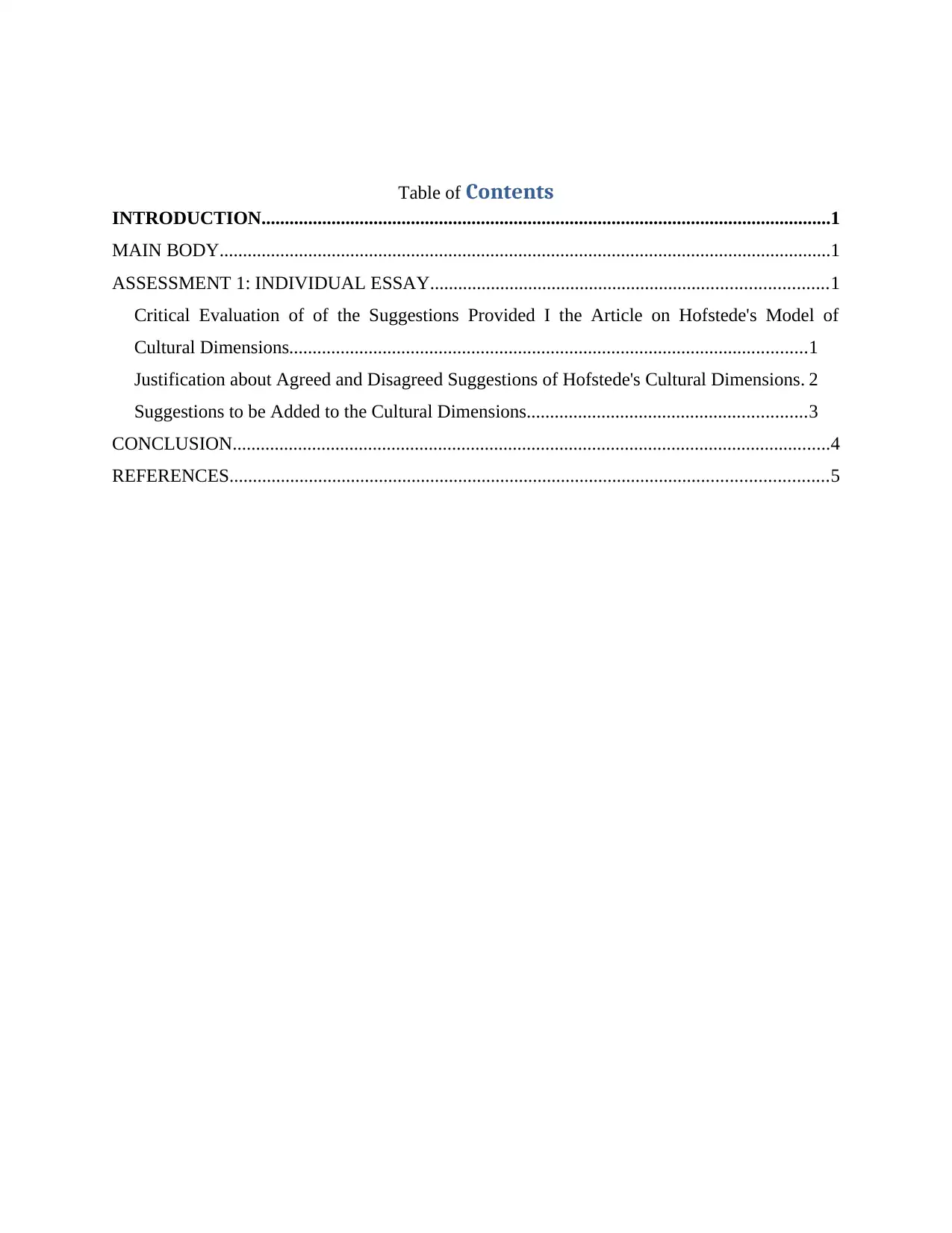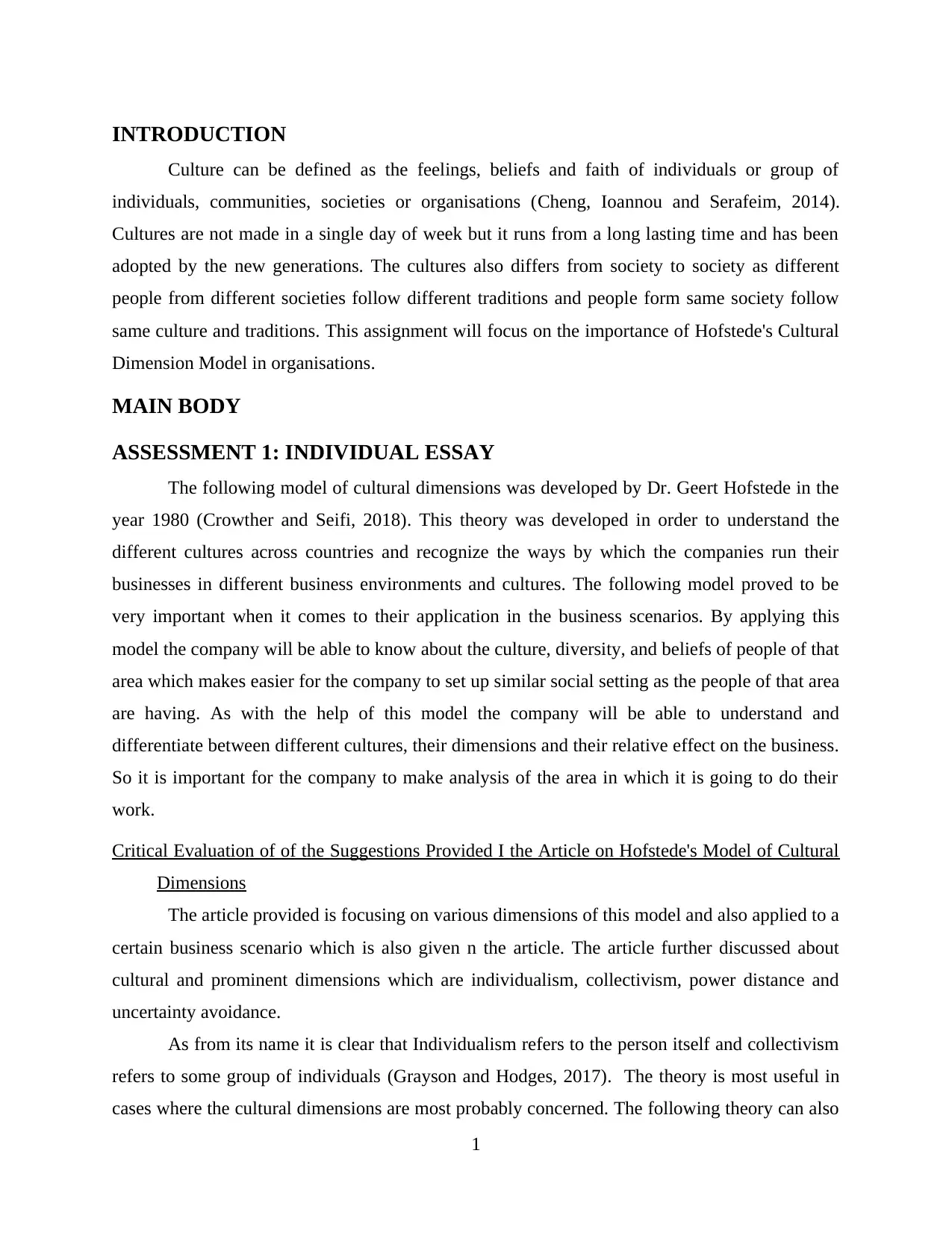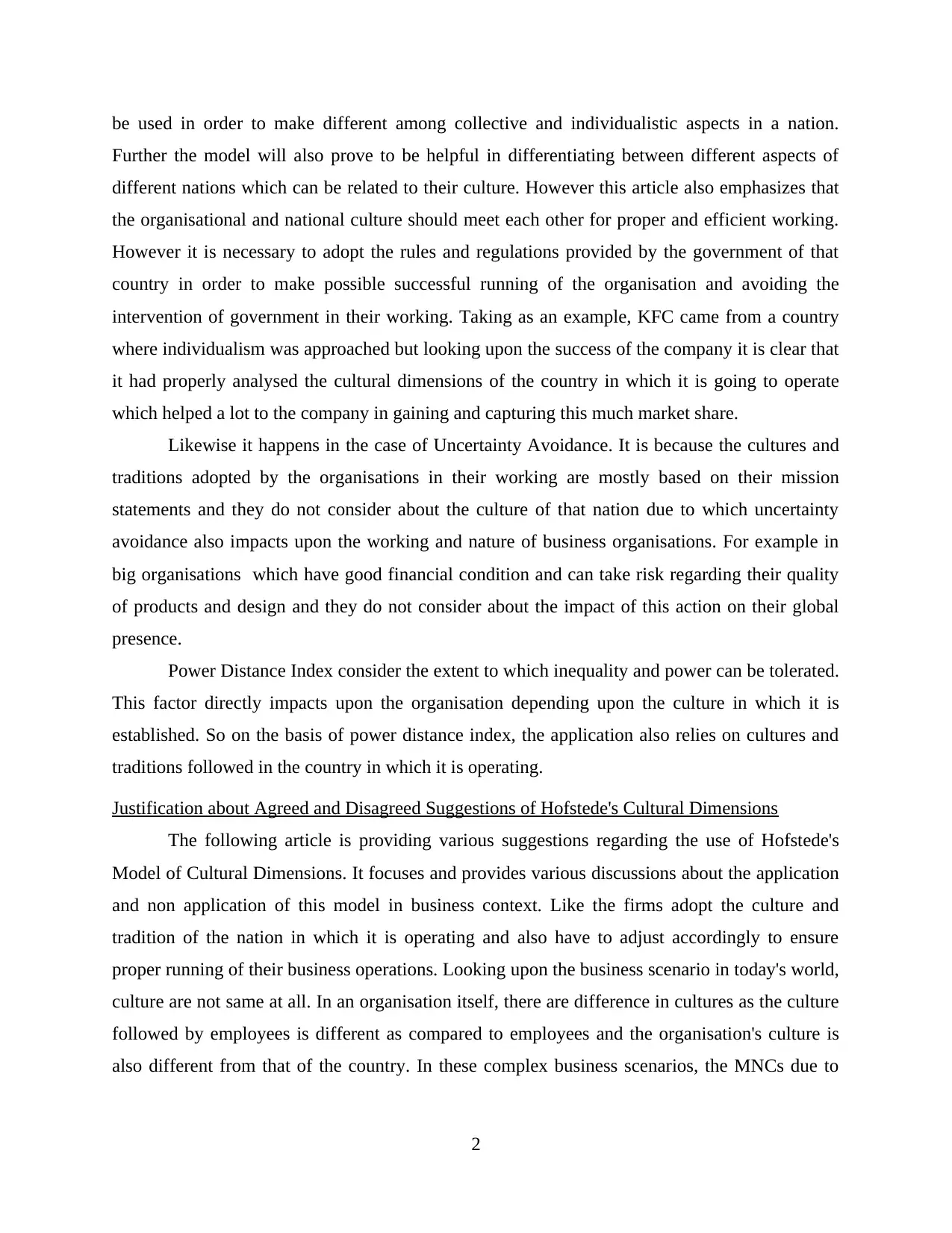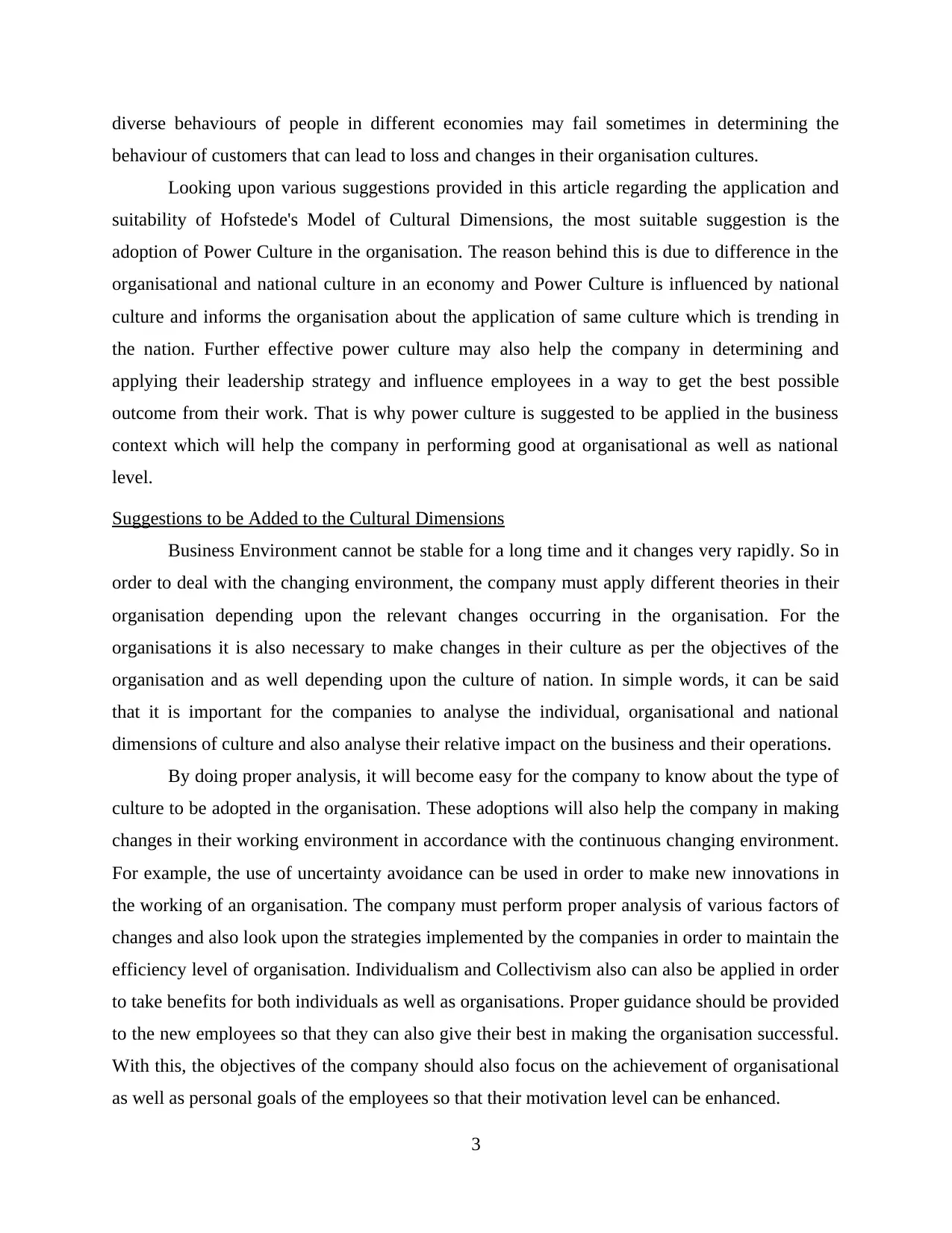Assessment: Hofstede's Model of Cultural Dimensions Analysis Report
VerifiedAdded on 2021/01/02
|7
|1684
|169
Report
AI Summary
This report provides a critical analysis of Hofstede's Cultural Dimensions, exploring their significance in organizational settings. It begins with an introduction to the concept of culture and its impact on businesses, followed by an examination of Hofstede's model, including dimensions like individualism, collectivism, power distance, and uncertainty avoidance. The report critically evaluates the suggestions provided in an article about the model, justifying agreements and disagreements, and proposing additional dimensions to consider. It emphasizes the importance of aligning organizational and national cultures for successful business operations, using examples like KFC to illustrate the application of cultural dimensions. The report concludes by highlighting the dynamic nature of the business environment and the need for companies to adapt their strategies accordingly. It stresses the importance of considering individual, organizational, and national cultural dimensions to enhance employee motivation and organizational performance. The report concludes by emphasizing the practical applications of the model in gaining insights into organizational working and operational culture.

Study Skills
(Report and Essay)
(Report and Essay)
Paraphrase This Document
Need a fresh take? Get an instant paraphrase of this document with our AI Paraphraser

Table of Contents
INTRODUCTION..........................................................................................................................1
MAIN BODY...................................................................................................................................1
ASSESSMENT 1: INDIVIDUAL ESSAY.....................................................................................1
Critical Evaluation of of the Suggestions Provided I the Article on Hofstede's Model of
Cultural Dimensions...............................................................................................................1
Justification about Agreed and Disagreed Suggestions of Hofstede's Cultural Dimensions. 2
Suggestions to be Added to the Cultural Dimensions............................................................3
CONCLUSION................................................................................................................................4
REFERENCES................................................................................................................................5
INTRODUCTION..........................................................................................................................1
MAIN BODY...................................................................................................................................1
ASSESSMENT 1: INDIVIDUAL ESSAY.....................................................................................1
Critical Evaluation of of the Suggestions Provided I the Article on Hofstede's Model of
Cultural Dimensions...............................................................................................................1
Justification about Agreed and Disagreed Suggestions of Hofstede's Cultural Dimensions. 2
Suggestions to be Added to the Cultural Dimensions............................................................3
CONCLUSION................................................................................................................................4
REFERENCES................................................................................................................................5

INTRODUCTION
Culture can be defined as the feelings, beliefs and faith of individuals or group of
individuals, communities, societies or organisations (Cheng, Ioannou and Serafeim, 2014).
Cultures are not made in a single day of week but it runs from a long lasting time and has been
adopted by the new generations. The cultures also differs from society to society as different
people from different societies follow different traditions and people form same society follow
same culture and traditions. This assignment will focus on the importance of Hofstede's Cultural
Dimension Model in organisations.
MAIN BODY
ASSESSMENT 1: INDIVIDUAL ESSAY
The following model of cultural dimensions was developed by Dr. Geert Hofstede in the
year 1980 (Crowther and Seifi, 2018). This theory was developed in order to understand the
different cultures across countries and recognize the ways by which the companies run their
businesses in different business environments and cultures. The following model proved to be
very important when it comes to their application in the business scenarios. By applying this
model the company will be able to know about the culture, diversity, and beliefs of people of that
area which makes easier for the company to set up similar social setting as the people of that area
are having. As with the help of this model the company will be able to understand and
differentiate between different cultures, their dimensions and their relative effect on the business.
So it is important for the company to make analysis of the area in which it is going to do their
work.
Critical Evaluation of of the Suggestions Provided I the Article on Hofstede's Model of Cultural
Dimensions
The article provided is focusing on various dimensions of this model and also applied to a
certain business scenario which is also given n the article. The article further discussed about
cultural and prominent dimensions which are individualism, collectivism, power distance and
uncertainty avoidance.
As from its name it is clear that Individualism refers to the person itself and collectivism
refers to some group of individuals (Grayson and Hodges, 2017). The theory is most useful in
cases where the cultural dimensions are most probably concerned. The following theory can also
1
Culture can be defined as the feelings, beliefs and faith of individuals or group of
individuals, communities, societies or organisations (Cheng, Ioannou and Serafeim, 2014).
Cultures are not made in a single day of week but it runs from a long lasting time and has been
adopted by the new generations. The cultures also differs from society to society as different
people from different societies follow different traditions and people form same society follow
same culture and traditions. This assignment will focus on the importance of Hofstede's Cultural
Dimension Model in organisations.
MAIN BODY
ASSESSMENT 1: INDIVIDUAL ESSAY
The following model of cultural dimensions was developed by Dr. Geert Hofstede in the
year 1980 (Crowther and Seifi, 2018). This theory was developed in order to understand the
different cultures across countries and recognize the ways by which the companies run their
businesses in different business environments and cultures. The following model proved to be
very important when it comes to their application in the business scenarios. By applying this
model the company will be able to know about the culture, diversity, and beliefs of people of that
area which makes easier for the company to set up similar social setting as the people of that area
are having. As with the help of this model the company will be able to understand and
differentiate between different cultures, their dimensions and their relative effect on the business.
So it is important for the company to make analysis of the area in which it is going to do their
work.
Critical Evaluation of of the Suggestions Provided I the Article on Hofstede's Model of Cultural
Dimensions
The article provided is focusing on various dimensions of this model and also applied to a
certain business scenario which is also given n the article. The article further discussed about
cultural and prominent dimensions which are individualism, collectivism, power distance and
uncertainty avoidance.
As from its name it is clear that Individualism refers to the person itself and collectivism
refers to some group of individuals (Grayson and Hodges, 2017). The theory is most useful in
cases where the cultural dimensions are most probably concerned. The following theory can also
1
⊘ This is a preview!⊘
Do you want full access?
Subscribe today to unlock all pages.

Trusted by 1+ million students worldwide

be used in order to make different among collective and individualistic aspects in a nation.
Further the model will also prove to be helpful in differentiating between different aspects of
different nations which can be related to their culture. However this article also emphasizes that
the organisational and national culture should meet each other for proper and efficient working.
However it is necessary to adopt the rules and regulations provided by the government of that
country in order to make possible successful running of the organisation and avoiding the
intervention of government in their working. Taking as an example, KFC came from a country
where individualism was approached but looking upon the success of the company it is clear that
it had properly analysed the cultural dimensions of the country in which it is going to operate
which helped a lot to the company in gaining and capturing this much market share.
Likewise it happens in the case of Uncertainty Avoidance. It is because the cultures and
traditions adopted by the organisations in their working are mostly based on their mission
statements and they do not consider about the culture of that nation due to which uncertainty
avoidance also impacts upon the working and nature of business organisations. For example in
big organisations which have good financial condition and can take risk regarding their quality
of products and design and they do not consider about the impact of this action on their global
presence.
Power Distance Index consider the extent to which inequality and power can be tolerated.
This factor directly impacts upon the organisation depending upon the culture in which it is
established. So on the basis of power distance index, the application also relies on cultures and
traditions followed in the country in which it is operating.
Justification about Agreed and Disagreed Suggestions of Hofstede's Cultural Dimensions
The following article is providing various suggestions regarding the use of Hofstede's
Model of Cultural Dimensions. It focuses and provides various discussions about the application
and non application of this model in business context. Like the firms adopt the culture and
tradition of the nation in which it is operating and also have to adjust accordingly to ensure
proper running of their business operations. Looking upon the business scenario in today's world,
culture are not same at all. In an organisation itself, there are difference in cultures as the culture
followed by employees is different as compared to employees and the organisation's culture is
also different from that of the country. In these complex business scenarios, the MNCs due to
2
Further the model will also prove to be helpful in differentiating between different aspects of
different nations which can be related to their culture. However this article also emphasizes that
the organisational and national culture should meet each other for proper and efficient working.
However it is necessary to adopt the rules and regulations provided by the government of that
country in order to make possible successful running of the organisation and avoiding the
intervention of government in their working. Taking as an example, KFC came from a country
where individualism was approached but looking upon the success of the company it is clear that
it had properly analysed the cultural dimensions of the country in which it is going to operate
which helped a lot to the company in gaining and capturing this much market share.
Likewise it happens in the case of Uncertainty Avoidance. It is because the cultures and
traditions adopted by the organisations in their working are mostly based on their mission
statements and they do not consider about the culture of that nation due to which uncertainty
avoidance also impacts upon the working and nature of business organisations. For example in
big organisations which have good financial condition and can take risk regarding their quality
of products and design and they do not consider about the impact of this action on their global
presence.
Power Distance Index consider the extent to which inequality and power can be tolerated.
This factor directly impacts upon the organisation depending upon the culture in which it is
established. So on the basis of power distance index, the application also relies on cultures and
traditions followed in the country in which it is operating.
Justification about Agreed and Disagreed Suggestions of Hofstede's Cultural Dimensions
The following article is providing various suggestions regarding the use of Hofstede's
Model of Cultural Dimensions. It focuses and provides various discussions about the application
and non application of this model in business context. Like the firms adopt the culture and
tradition of the nation in which it is operating and also have to adjust accordingly to ensure
proper running of their business operations. Looking upon the business scenario in today's world,
culture are not same at all. In an organisation itself, there are difference in cultures as the culture
followed by employees is different as compared to employees and the organisation's culture is
also different from that of the country. In these complex business scenarios, the MNCs due to
2
Paraphrase This Document
Need a fresh take? Get an instant paraphrase of this document with our AI Paraphraser

diverse behaviours of people in different economies may fail sometimes in determining the
behaviour of customers that can lead to loss and changes in their organisation cultures.
Looking upon various suggestions provided in this article regarding the application and
suitability of Hofstede's Model of Cultural Dimensions, the most suitable suggestion is the
adoption of Power Culture in the organisation. The reason behind this is due to difference in the
organisational and national culture in an economy and Power Culture is influenced by national
culture and informs the organisation about the application of same culture which is trending in
the nation. Further effective power culture may also help the company in determining and
applying their leadership strategy and influence employees in a way to get the best possible
outcome from their work. That is why power culture is suggested to be applied in the business
context which will help the company in performing good at organisational as well as national
level.
Suggestions to be Added to the Cultural Dimensions
Business Environment cannot be stable for a long time and it changes very rapidly. So in
order to deal with the changing environment, the company must apply different theories in their
organisation depending upon the relevant changes occurring in the organisation. For the
organisations it is also necessary to make changes in their culture as per the objectives of the
organisation and as well depending upon the culture of nation. In simple words, it can be said
that it is important for the companies to analyse the individual, organisational and national
dimensions of culture and also analyse their relative impact on the business and their operations.
By doing proper analysis, it will become easy for the company to know about the type of
culture to be adopted in the organisation. These adoptions will also help the company in making
changes in their working environment in accordance with the continuous changing environment.
For example, the use of uncertainty avoidance can be used in order to make new innovations in
the working of an organisation. The company must perform proper analysis of various factors of
changes and also look upon the strategies implemented by the companies in order to maintain the
efficiency level of organisation. Individualism and Collectivism also can also be applied in order
to take benefits for both individuals as well as organisations. Proper guidance should be provided
to the new employees so that they can also give their best in making the organisation successful.
With this, the objectives of the company should also focus on the achievement of organisational
as well as personal goals of the employees so that their motivation level can be enhanced.
3
behaviour of customers that can lead to loss and changes in their organisation cultures.
Looking upon various suggestions provided in this article regarding the application and
suitability of Hofstede's Model of Cultural Dimensions, the most suitable suggestion is the
adoption of Power Culture in the organisation. The reason behind this is due to difference in the
organisational and national culture in an economy and Power Culture is influenced by national
culture and informs the organisation about the application of same culture which is trending in
the nation. Further effective power culture may also help the company in determining and
applying their leadership strategy and influence employees in a way to get the best possible
outcome from their work. That is why power culture is suggested to be applied in the business
context which will help the company in performing good at organisational as well as national
level.
Suggestions to be Added to the Cultural Dimensions
Business Environment cannot be stable for a long time and it changes very rapidly. So in
order to deal with the changing environment, the company must apply different theories in their
organisation depending upon the relevant changes occurring in the organisation. For the
organisations it is also necessary to make changes in their culture as per the objectives of the
organisation and as well depending upon the culture of nation. In simple words, it can be said
that it is important for the companies to analyse the individual, organisational and national
dimensions of culture and also analyse their relative impact on the business and their operations.
By doing proper analysis, it will become easy for the company to know about the type of
culture to be adopted in the organisation. These adoptions will also help the company in making
changes in their working environment in accordance with the continuous changing environment.
For example, the use of uncertainty avoidance can be used in order to make new innovations in
the working of an organisation. The company must perform proper analysis of various factors of
changes and also look upon the strategies implemented by the companies in order to maintain the
efficiency level of organisation. Individualism and Collectivism also can also be applied in order
to take benefits for both individuals as well as organisations. Proper guidance should be provided
to the new employees so that they can also give their best in making the organisation successful.
With this, the objectives of the company should also focus on the achievement of organisational
as well as personal goals of the employees so that their motivation level can be enhanced.
3

Lastly where the power distance culture is taken into consideration, its applicability will
best suit to the organisational as well as individual goals of the person (Hart, 2018). For example,
the company make the involvement of employees in decision making process. It is because the
decisions made by the company will also impact upon the working of employees also. This
factor provides their employees sufficient right to put their concern in front of the company and
also getting feedbacks for their work done. Employees can also provide good ideas and
suggestions to the company which can give a rapid increase in the growth and development of
the company as a whole. Further their morale and efficiency in work will also be enhanced by
considering them in the decision making process.
CONCLUSION
On the basis of above assignment, it can be concluded that Hostede’s dimensions of
culture assists in gaining an insight into the overall working and operational culture of the
organisation. Various dimensions of this culture model are examined in this which explore the
features of different cultures.
4
best suit to the organisational as well as individual goals of the person (Hart, 2018). For example,
the company make the involvement of employees in decision making process. It is because the
decisions made by the company will also impact upon the working of employees also. This
factor provides their employees sufficient right to put their concern in front of the company and
also getting feedbacks for their work done. Employees can also provide good ideas and
suggestions to the company which can give a rapid increase in the growth and development of
the company as a whole. Further their morale and efficiency in work will also be enhanced by
considering them in the decision making process.
CONCLUSION
On the basis of above assignment, it can be concluded that Hostede’s dimensions of
culture assists in gaining an insight into the overall working and operational culture of the
organisation. Various dimensions of this culture model are examined in this which explore the
features of different cultures.
4
⊘ This is a preview!⊘
Do you want full access?
Subscribe today to unlock all pages.

Trusted by 1+ million students worldwide

REFERENCES
Books and Journals
Cheng, B., Ioannou, I. and Serafeim, G., 2014. Corporate social responsibility and access to
finance. Strategic management journal. 35(1). pp.1-23.
Crowther, D. and Seifi, S. eds., 2018. Redefining Corporate Social Responsibility. Emerald
Group Publishing.
Du, S., Bhattacharya, C.B. and Sen, S., 2010. Maximizing business returns to corporate social
responsibility (CSR): The role of CSR communication. International journal of
management reviews. 12(1). pp.8-19.
5
Books and Journals
Cheng, B., Ioannou, I. and Serafeim, G., 2014. Corporate social responsibility and access to
finance. Strategic management journal. 35(1). pp.1-23.
Crowther, D. and Seifi, S. eds., 2018. Redefining Corporate Social Responsibility. Emerald
Group Publishing.
Du, S., Bhattacharya, C.B. and Sen, S., 2010. Maximizing business returns to corporate social
responsibility (CSR): The role of CSR communication. International journal of
management reviews. 12(1). pp.8-19.
5
1 out of 7
Related Documents
Your All-in-One AI-Powered Toolkit for Academic Success.
+13062052269
info@desklib.com
Available 24*7 on WhatsApp / Email
![[object Object]](/_next/static/media/star-bottom.7253800d.svg)
Unlock your academic potential
Copyright © 2020–2025 A2Z Services. All Rights Reserved. Developed and managed by ZUCOL.





